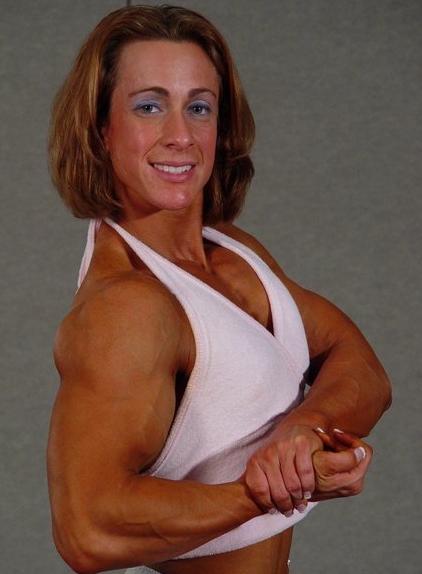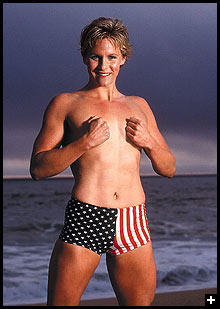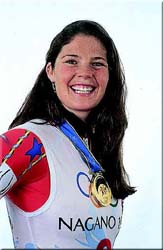Female Athletes, Economics, and Beauty
Female Athletes, Economics, and Beauty

I'll bet you were spurred to click to this SBS blog column because of the great photo of Female Bodybuilder Amanda Dunbar, huh?
Gotcha!
That's part of the trick, and the point of this exercise: as women athletes and women performing in sports become more and more common, it is as natural as drinking water to expect to see images of athletic strong women.
I mean, we've got to sell tickets and move product, so what's wrong with that?
Well, in some quarters everything is wrong with that.
ABC News recently offered a good article on this very subject, and which can be read at http://abcnews.go.com/sections/nightline/DailyNews/womens_sports020831.html Let's look at what some people had to say to ABC News about women "showing their bodies" while playing sports, or off the field for that matter:
"There's no evidence that it has ever helped a sport to expose women or to sexualize women," says Mariah Nurton, an author who as Mariah Burton Nelson played basketball professionally and for Stanford University.
"It has been tried many times going back to at least Jan Stevenson and Laura Bow in the '70s," she adds. "It didn't help women's golf. In fact, it can become kind of a laughingstock. It, it focuses people's attention on the sexual aspect and clouds the athletic aspect and clouds the athletic aspect.
"Women have always been degraded by being disrobed and that option I think will always be open to women," Nurton says. "And women will be offered a lot of money to take their clothes off. But what happens when they do is they lose respect. It's a mistake for female athletes to go ahead and agree to do that and it can be damaging to all of women's sports when female athletes are seen as sex objects rather than as athletes."
Christine Brennan, a sports columnist for USA Today and a consultant for ABCNEWS, says women's sports need to progress in their marketing approach.
"We seem to be still pandering to the frat house when many viewers of women's sports are 12-year-old girls with their 40-year-old dads," she says.
On top of those views, the Women's Sports Foundation, without question the leading promoter of women's sports in America, came out in force against women using sex or offering any image that could be considered sexual to "sell" their sport.
I'll take this view, to get the debate ball rolling but I do believe it: it's impossible for women to play a sport without a "sexual perspective" being a part of the activity. Someone, male or female, will look at the woman athlete sexually, and therefore pay attention to what they do, and the sport they "do it" in, for that reason.
Even if they don't admit it.
Thus, attempting to stem the presentation of the image of the "sexy woman athlete" is to try to wreck the poster-purchasing desires of not only every man, but also teenage boy, or lesbian woman for that matter.
Opponents of this view claim that there is a "double standard" where men don't have to show their bodies to be considered good at a sport. But that's not a logical argument for several reasons: male athletes like Mark Spitz in his day are commonly featured in "skin" calendars posted on the walls of many a 17-year-old girl.
The poster costs money to buy, and no one ever said that Spitz didn't deserve his gold medals.
The only real double standard at play is one that says "men can; women can't." Let's explore the different variations of this theme:
1) Men can make a lot of money; women can't
2) Men can run corporations; women can't
3) Men can look strong and muscular; women can't
4) Men can be considered sexy and good at sports; women can't
Let's focus on the last point, number four. Of all of the double standards that's the one that -- if permitted to persist -- can wreck the growth of female athletics. How? Well, if a woman is afraid to work out "too much" because they will be considered "less sexy" even if it helps them play a sport better, they will not reach their potential in athletics. Thus, we're robbed of seeing the next Jenny Thompson or Brandy Chastain.
"Hey, wait a minute! Why do I know those names?" You ask?
Because Jenny Thompson, winner of seven -- not one but seven -- Olympic gold medals was criticized for posting in Sports Illustrated with only her fists on her chest and American flag shorts, creating a photo that is arresting to some, shocking to others, and simply "unflagging" to SI:

No one took away her gold, Sports Illustrated sold a lot of copies of that issue, and Ms. Thompson's value on the athletic spokesperson circuit increased, and allowed her to afford med school at Columbia. But that's didn't stop the cries against her action, in fact I can hear them now.
Screams of protest that were also directed at Ms. Chastain for the very spontaneous act of taking off her soccer jersey in celebration of the US Women's World Cup victory. She wasn't naked; the Nike logo on her sports bra was in full view.
Ms. Chastain's action in part led to the launch of the WUSA. It wasn't just her act however, but the idea and image of beautiful, strong, attractive women coming together to win an athletic event when a significant part of the World was watching. Her move, scream, and "strip" encapsulated the energy associated with the event. Where the WUSA failed was in developing a way to bottle and sell that experience. Yes, sex is part of it.
But my argument is that by suggesting that women should not show strong bodies, try to be as strong as men, or be as exposed in the media as men is to effectively blunt the growth of female athletics. In the end, women are relegated to the same "common" roles that some have worked to overcome.
The real problems of bias against women is not in "expression of sexual bodies in the media," but does come in deeper examples on television, as expressed in a paper called "Gender Stereotyping in Televised Media Sport Coverage" (http://www.findarticles.com/cf_dls/m2294/1999_Oct/59426460/p1/article.jhtml?term=)
Nathalie Koivula, the author, finds that: "The general results of the present study add to earlier findings that media continues to reinforce the categorization of sports according to traditional views on gender-appropriateness, which in turn affect an individual's attitudes regarding both her or his own, as well as others, sports participation. The general finding from this study and related research is that the news media consistently contributes to the reproduction of traditional expectations of men and women and to the construction of a social stratification that enhances and naturalizes gender differences."
Ms. Koivula observes that such subtle habits as calling women athletes by their first name (Anna) where male athlete are called by their last name (Jordan), marginalization of women athletes, especially in sports regarded as masculine, and failing to give significant coverage to women's sports on news telecasts are the underpinnings of the true bias against women's sports.
Focusing on hiding women's bodies: asking Brandy to "cover up" next time, or preventing Anna from making videos is not going to save women's sports. Indeed, in the rampant world wide chase for the eyeballs of the consumer, acts like those may not only save women's sports, but cause it to explode.
There is already substantial evidence of this. According to the NCAA:
"The proportion of females competing in Division I intercollegiate athletics increased to 40 percent in 1997-98, up from 37 percent in 1996 and 31 percent in 1992. The average number of female participants per university increased from 130 in 1996 to 158 in 1998." http://www.ncaa.org/releases/research/1999102501re.htm
Some may point to Title IX legislation, but (not to diminish the importance of that legislation) logically having women's sports programs in place does not guarantee that women will participate in those programs.
The reason for this increase is simply women athletes have been seen more and more on television from 1982 to 1998 (due to the advent of cable television, which brought ESPN, Fox Sports, and the Regional Sports Network concept) and the women who have gotten this exposure have done so primarily via college sports. Indeed, there are still so few professional sports opportunities for women that college programs, particularly for basketball, have effectively took the place of pro sports programs in TV exposure.
One exception that must be noted here surrounds the success of alpine skier Picabo Street. Called "the greatest downhill skier in the World" by some, Street has combined a competitive killer instinct, great looks, and supreme marketing. Still Street's heroics would not have been noticed by as many people were it not for the advance of sports on television. 
Still, Street excels because she's good. Very good. Indeed, while she's been able to capitalize on her looks, she hasn't went to extreme measures to do so. But there's no doubting, or hiding, her appearance. It does sell. She has a wholesome look and "girl next door" sex appeal that sponsors from Sprint to Budweiser pay for.
I think what's lost here in the total discussion (and powerful emotions sometimes expressed) is that athletes in general command endorsement dollars. There are two ways to gain more earnings: being good or being sexy. If one can combine both and draw the public's attention, they win a special place in American pop culture and the fiscal returns to show for it.
In my view, there's nothing that can be done to change this dynamic in our society. It will always be a part of the fabric of the business of sports in America and around the World, and will only intensify as communications technology improves.
The question is how do we create an approach that makes more money for women athletes? We can't go with what I call "The business of cultural denial." It's costing women's sports, and creating a limit to its growth within the sports industry.
If it continues, we will see the death of what has been a "Golden Age" of women's sports. Already, we've lost the WUSA, and the WNBA is being restructured. No one is seriously working to form a new women's league in any sport. Without action, we will see a contraction of professional sports opportunities for women within the next five years.
Women who look strong, play sports, and show their muscularity must be considered the norm if women's sports are to grow beyond current levels. Otherwise, the glass ceiling may already have been reached. Advertisers, event planners, corporations, and agents can all gain in this practice.
Female athletes, like Professional Triathlete Rachel Sears, who my firm, Sports Business Simulations, Inc. sponsors, win a huge number of events, but who's going to know if they don't get exposure?

This holds new avenues for sports marketers, provided they can successfully produce an argument to corporations that women athletes are bankable. To do this, more -- not less -- male mainstream eyeballs must be captured. To offer proof of this point, the magazine Sports Illustrated for Women was recently cancelled. The reason given by some sources is that its content was targeted at a female audience, rather than both male and female groups of casual "sports consumers."
The problem is that women's sports and women's sports content can't count on an exclusively female audience to consistently pay the bills. An approach that appeals to both men and women is the key.
For those who object to this approach, I ask this question: why can't we find ways to funnel the extra money gained from this new level of exposure I call for into fiscal support for women's sports at the high school and college level? Heck, why not pros too? There may be so much money gained, one could resurrect the WUSA.
OK. I've had my say. It's your turn. Click on "Comment on this Blog" below.
Zennie Abraham
Chairman and CEO
Sports Business Simulations
For sports and concert tickets click here on these words
| 1 - 1 of 1 articles |
On This Site
Search This Site
Syndicate this blog site
Powered by BlogEasy
Free Blog Hosting